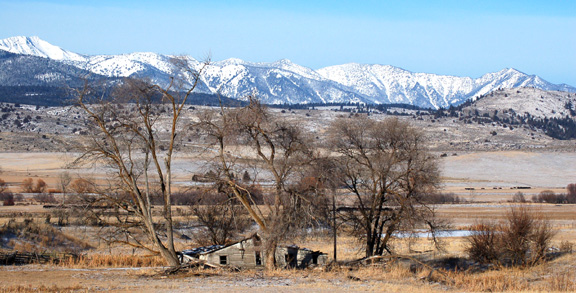-Trap-Neuter-Release Program
-Resisting Delisting ~ Idaho's Wolves & Livestock's Influence - video
-Youchoose at Youtube
_______________________________________________
Is TNR A Humane Solution to the Feral Cat Problem?
Four years ago, I was a volunteer at a county animal shelter. It was a pretty unpleasant experience in many ways, but I enjoyed working with the abandoned, or otherwise abused pets. It was pleasing to find out that pitbulls can have a loving and endearing spirit, and it was satisfying to see a local person leave with a purring kitten or tail-wagging dog. I was truly saddened to find out why the fellow with the flatbed truck came in every two weeks to get those big black barrels out back. If, after a few weeks, an animal didn’t get a home, it ended up in one of the black barrels. It is a hard reality, that even as an adult, I didn’t want to face.
In recent times there has been a fairly successful effort to demonize those who favor time-tested methods of feral cat control. They have been relegated to the political and social sidelines by the “compassionately correct,” who have placed control of feral cats under the bureaucratized, “nanny state” government and NGO umbrella of so-called “humane” treatment. In that vein, over the last year or more there have been several articles in the local papers about our feral cat problem and the trap-neuter-release program (TNR). The last article that I am aware of that even hinted there might be any problem with feeding strays, or with TNR in general, was an August 2006 Herald article by Alex Pahunas, but no article that I am aware of, made a real effort to let readers know about the many negative aspects of TNR or about the debate that has been simmering for several years. In the last few weeks, there were two articles and two editorials promoting successes of the program. Both editorials suggested that the City Council was wrong to deny continued funding for the program, and one seemed to think that TNR was a humane solution, while implying that nothing less than Sainthood would do for the lead proponents of the program.

Feral Cat on Successful Hunt (AU.gov)
My reaction to the problem is that it is better than nothing, not particularly humane, and that it is not the best solution or the wisest use of resources. While it likely will reduce feral cat populations in the long run, it ignores a primary source of the problem: pet cats that are not neutered or spayed. It also ignores other important issues that are discussed below, not the least of which are deleterious effects on songbird populations and the problems released feral cats pose to taxpayers and other residents who are not particularly infatuated with them.
Most definitions of the word “humane” have to do with showing compassion, kindness and mercy towards other humans or animals. Some people have a pretty short list of the animals, or even humans, they have compassion and concern for. They can see themselves and others as humane if they refuse to euthanize cats, even if domestic and feral cats kill millions of birds, mammals, amphibians and reptiles every year, and even if some of these same people support American policies that have killed millions of innocent civilians around the globe. It is that kind of moral and ethical flexibility that makes life a breeze for some, and a bad dream for others.
Local proponents have promoted TNR as both humane and legal. Many studies over the last decade have questioned whether it is either, and I would add that it is not the most efficient use of taxpayer or other dollars.
While proponents claim that spaying or neutering feral cats and releasing them back into the wild is more humane than traditional methods involving euthanasia, opponents (yes, there are many), point out that the life of a feral cat can be a bit torturous, especially in Baker County during winter. The lives of feral cats are much shorter than those of house cats (as much as three times shorter) for good reason. Besides the difficulty of finding adequate shelter, their living conditions subject them to suffering and miserable deaths from accidents with vehicles, attacks by other animals (including humans, dogs, and other cats), poisoning, disease and possible starvation. Is subjecting cats to a dangerous, painful and marginal existence really humane?

Feral Cats Lead A Torturous Existence
(NPS.gov photo)
Cats are not only more likely to be victims of feline disease in the wild, they also spread diseases to other animals and humans. The list is long, but includes such favorites as rabies, toxoplasmosis, cat scratch fever and worms. Is unnecessarily maintaining a large reservoir of these diseases in the feral cat population, from where they can be spread to humans, pet cats, or other animals, a wise and humane policy?
Cats, like most predators, evolved to become efficient killers. Even well fed cats can’t control their instinct to kill when confronted with their natural small animal prey—like that hummingbird whose return you had been patiently waiting for.

Rufous Hummingbirds migrate to Baker City (© Christopher Christie)
Cats are thought to have played an important part in the extinction of 30 species of birds worldwide. Each pet cat is estimated to kill about 32 small animals per year and feral cats, which may number as many as 60 million in the U.S., are thought to kill far more than that. It is estimated that cats kill hundreds of millions of songbirds and over a billion other animals in the U. S. every year. Granted, some of those animals are introduced pests like the house sparrow and starling, which do a good deal of damage themselves, but many are not. Some are neotropical migrants like hummingbirds and warblers, who already have enough troubles surviving in our over-populated, bruised and battered world. Unlike the house sparrow, neotropicals are protected by the Migratory Bird Treaty Act, and other victims may be covered by other wildlife protection laws as well. Is enabling the slaughter of birds and other animals by feral cats through the TNR program really humane?

Feral Cats kill millions of birds annually
(Australian Government photo)
There are other problems caused by uncared for cats as well. Some of you may have experienced the unmitigated joy of unknowingly stepping in an unplanned cat box, which previously had been your mulched parking area, before you walk into the house. Others of you may have been welcomed by the delightfully perfumed scent of a large male cat who sprayed down your shed after commandeering it for living quarters. Protecting other small pets and young farm animals from feral cats can also become a vexing problem.
Effectiveness
Arguments are made and studies are cited for both sides with regard to the effectiveness of the programs in reducing feral cat populations. In the absence of definitive studies, logic tells us that euthanasia, in combination with spay-neuter programs and education, is at least as effective as TNR, and it addresses a host of other problems associated with feral cats that TNR does not. Feral cat advocates and animal “rights” activists have deluged the internet with half-baked opinions and studies of the issue, but emotional appeals are more often to be found than facts.
Obviously, the math for a reduction in the cat population per spayed female remains the same whether the cat has been spayed or euthanized, so both methods are beneficial in that respect. Both programs will reduce the population of feral cats over time, but TNR has more uncontrollable variables than euthanasia. For example, TNR depends in part on people who are able and willing to feed feral cat colonies. When feeders, who are often elderly, become ill, die, or simply can no longer bear the costs, cats may starve or disperse. Cats, being smarter than some may assume, also become wary of traps, which makes it difficult to bring them in again for the additional vaccinations which are required for humane treatment and disease control. On the other hand, those with a feral cat problem are motivated to do something about it, and when they trap an animal for euthanasia, it won’t have another chance to outwit someone else who is defending their property from feline offences. An added bonus is that these people don’t bill the city or county for their work. One thing is certain; euthanized cats don’t breed, spray your shed, yowl outside your window at night, or kill your favorite hummingbird at the feeder.
Legal issues
As mentioned previously, the Migratory Bird Treaty Act makes killing neotropical birds and other migratory birds, like hummers, unlawful. There are questions as to whether it is legal to release captured feral cats back into feral status when one knows that these cats will subsequently be responsible for killing migratory birds. Corporations have been convicted for allowing the release of polluting substances that have resulted in the deaths of these birds, so it is not far-fetched to imagine convictions for releasing feral cats back into the community when it is clear that they will resume killing birds, including birds protected by law. The same applies to animals protected by other laws as well.

Additionally there exist applicable Oregon State laws in Title 16, Chapter 167, that protect animals from cruelty, abuse and abandonment. There are questions as to whether persons who maintain cat colonies are providing “minimum care,” which is defined as “care sufficient to preserve the health and well-being of an animal,” including food, water, housing, and veterinary care.
Also, those who release feral cats back into the community may be guilty of animal “abuse,” which is defined to be when a “person intentionally, knowingly or recklessly . . . Causes serious physical injury to an animal; or . . . Cruelly causes the death of an animal.” Intentionally releasing a feral cat, that is known to be an indiscriminate serial killer of dozens of birds and other small animals every year , could easily be interpreted as animal abuse.
Another State law, 167.340, the animal abandonment statute, also states that “A person commits the crime of animal abandonment if the person intentionally, knowingly, recklessly or with criminal negligence leaves a domesticated animal at a location without providing for the animal's continued care.” It is not clear weather some or all feral cats may be defined as domesticated animals.
I do not necessarily agree with all these State laws, but the question I, and others, have is whether or not TNR is in compliance with them.
Costs of TNR Versus Euthanasia
One 2004 study by the Journal of the American Veterinary Medical Association found that euthanasia was more effective than TNR for managing feral cats. Feral cat activists have tried to shoot down that study by complaining it didn’t factor in cost and public opinion.
One of the efforts tried to show that euthanasia is incredibly expensive by using figures from large cities with established animal shelters, but the study didn’t provide apples to apples comparisons. For euthanasia, they included costs to pick up, house, and dispose of an animal, but they then forgot to include trap, release and other costs when comparing the euthanasia cost to the cost for TNR. In Baker City’s case, the papers report that Baker City vets charge $60 to $70 to spay and between $35 and $45 to neuter. In Baker City, euthanasia fees for cats run between $20.00 to $40.00, and some charge a $10 disposal charge. Animal Clinic at 10th and Campbell, charges a flat $20.00. You do the math. While veterinarians no doubt appreciate the TNR program for a number of altruistic reasons, it should also be noted that it serves their economic interest. There is no doubt though that they could support a lower cost euthanasia program, coupled with a low-cost, donor and City supported spay-neuter program, and so could city taxpayers.
If government would just trust the judgment of the people affected by marauding feral cats, instead of telling them how they must deal with the problem, the cost of a remedy would drop like a rock.
No study that I am aware of has factored in the environmental costs for the slaughter of birds and other small animals into the TNR program, nor have they included costs for feeding and all the necessary vaccinations. Surely no community nuisance costs have been included in TNR comparisons for the time residents spend alleviating the damage done by male cats spraying in once pleasant places (neutered cats still spray), or for deodorizing and vet bills when one’s dog gets in a tangle with a “humane” person’s recently released furry feral friend. These are obviously not costs that would be incurred by a euthanasia program after a feral cat is initially trapped.
Public opinion, may, or may not, be a problem. If the papers would do their job and make the public aware of the pros and cons of each possible solution, then community supported euthanasia, in combination with spay-neuter programs, might not be such a hard sell. This is especially so in a region where hunters abound, and where people are not particularly squeamish about controlling pestiferous animal populations through lethal means. Even with our local media’s one-sided approach, Bakerites may already have serious questions about TNR, and about using their tax dollars in a way that ignores so many problems associated with released feral cats.
Solutions
We all know that ignoring the problem of feral cats won’t make them go away. Recognizing that the TNR program is seriously flawed is obviously not enough. Other programs, that don’t carry the deleterious side effects of TNR, can and should be implemented. The City still needs to deal with feral cats and they can help in several ways.
• The City should contract with one or more local vets for publicly available, inexpensive, spay-neuter and euthanasia services.
• Let citizens take care of the problem without harassment by law enforcement, and irrational feral cat and animal rights advocates by allowing those affected to deal with or bring in strays that are causing problems where they live.
• The City should step forward and fund a low-cost spay-neuter program for low income residents. Animal advocates could do their part by donating to the City’s program and finding grants to support it.
• Begin a continuing education program informing people about irresponsible breeding, keeping cats inside, and the low-cost alternatives available to them.
• If necessary, the city should begin licensing cats, just as they do dogs, and include financial incentives for spay-neutering.

Cats Can Live Happily Indoors
Private donor financed TNR is fine, but the most low cost and humane solution would be to initially let affected citizens solve their own feral cat problem. Taking feral cats to the local vets for euthanasia, rather that spay-neuter and release, will accomplish a part of the population control objectives. That, coupled with owner education and a city financed spay/neuter program to help financially strapped pet owners, will begin to alleviate the problem. Asking cat owners in the city to keep their cats inside would also help prevent breeding, the killing of small animals, and damage to neighboring property. Those who allow their pets to reproduce without a reasonable and realistic plan for finding decent homes for the offspring should not be tolerated. The licensing of domestic cats, as is done with dogs, along with similar financial incentives, such as licensing discounts for owner-initiated spay/neutering, should be used if the first steps don’t bring the necessary results. Licensing cats would also make it easy to know whether a cat is the pet of a legally responsible owner. One thing is for sure--TNR is only an effective and “humane” solution for those whose concern for abandoned cats is far greater than their compassion for other animals or their concern for the community’s health, tranquility, and welfare.
Nobody wants to perpetuate the black barrels I spoke of earlier. Nor do citizens want to be put in the position of having to defend themselves and their animal friends from feral cats and the problems they bring. We don’t want to decide whether it is more humane to kill birds than cats, and through the knowledge gained by education, the help of low-cost, community supported spay/neuter/euthanasia programs, and licensing if necessary, we won’t have to. With a sensible policy, choosing between being humane to cats or humane to other critters, shouldn’t be a problem.
Related articles:
FERAL CAT COLONIES IN FLORIDA: THE FUR AND FEATHERS ARE FLYING
A REPORT TO THE U.S. FISH & WILDLIFE SERVICE
http://conservation.law.ufl.edu/pdf/feralcat.pdf
Cats and Birds: Keeping Cats Indoors
http://www.umd.umich.edu/dept/rouge_river/cats.html
Kill the Cat That Kills the Bird?
http://www.nytimes.com/2007/12/02/magazine/02cats-v--birds-t.html?ref=todayspaper
_______________________________________________

Resisting Delisting ~ Idaho's Wolves & Livestock's Influence
This video provides a pretty good window into the mentality of the "shoot, shovel, and shut up" crowd.
http://www.youtube.com/watch?v=1r8PhnTL-c0
_______________________________________________
What do the Candidates Really Think?
Tired of trying to figure out what the candidates think about issues you care about?
Try: http://www.youtube.com/youchoose
This was mentioned as a good source by a media watchdog on last Friday's Bill Moyers program on PBS.
















